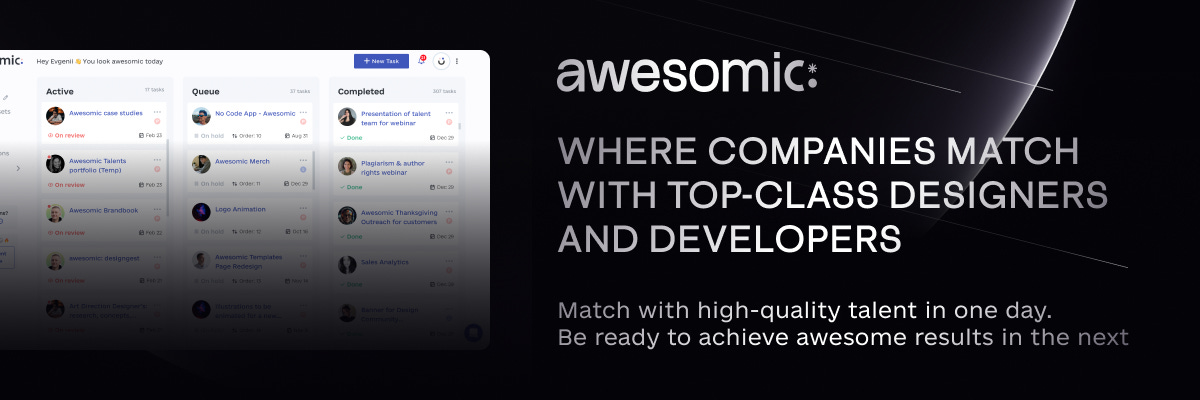Early Struggles and Failed Ventures
Marc Lou's entrepreneurial journey began with a series of setbacks.
After graduating from university, he decided to pursue his dream of becoming the "next Mark Zuckerberg" instead of taking a traditional job like his peers.
He lived with his parents and worked as a waiter part-time, making only $10 per hour while devoting his time to building a "Tinder for sports lovers" app.
After a year of work, Marc realized the app would never come to fruition due to his lack of skills and business acumen.
This led to a series of failed ventures, including an AI startup that raised venture capital but failed to attract customers.
Takeaway: Before diving into a big project, assess your skills and the market demand. Consider starting with smaller, more manageable projects to build your skills and understanding of the business landscape.
Today’s issue is sponsored by Awesomic
Great design fuels engagement, builds trust, and drives growth.
Awesomic matches you with vetted designers and devs in just 24 hours, so you can start your project right away—without the hassle of hiring or managing freelancers!
The Turning Point: Finding Product-Market Fit
Marc's breakthrough came when he shifted his focus to solving real problems for businesses.
He created a tool to help escape room businesses attract more customers.
Instead of building the product first, he followed a marketer's advice to sell it before making it.
Marc sent cold emails to potential clients and secured his first sale during a 42-minute call with an Australian business owner.
This approach led to his first sale and a valuable lesson in product-market fit.
Takeaway: Before building a product, reach out to potential customers directly. Use cold emails or calls to pitch your idea and secure pre-orders or commitments.
Adapting to Challenges: The COVID-19 Impact
As Marc's business grew to $4,000 in monthly recurring revenue, the COVID-19 pandemic hit, wiping out his income overnight.
He had to quickly pivot and find new opportunities in the changing market landscape.
Takeaway: Diversify your client base and revenue streams. Consider creating digital products or services that are less vulnerable to external shocks.
Rapid Iteration and Public Sharing
Marc adopted a new strategy of building and launching multiple small projects quickly.
He created and launched six projects in seven months, including Mood to Movie (a movie recommendation app) and Habits Garden (a habit tracker).
He shared his progress publicly on social media platforms, which helped him build an audience and get feedback.
Takeaway: Set a goal to launch a new project every 30-60 days. Use platforms like X or Product Hunt to share your progress and gather feedback.
Focusing on Pain Points and Monetization
As Marc continued to launch projects, he shifted his focus to creating "painkiller" apps that solved specific problems and included clear monetization strategies.
He implemented paywalls in his apps, ensuring users had to pay to access certain features or content.
This approach helped increase his monthly revenue from $1,000 to $4,000.
Takeaway: Identify a specific pain point in your target market and create a solution with a clear monetization strategy. Test different pricing models, such as freemium or tiered subscriptions.
Leveraging Existing Skills: The Birth of Ship Fast
Recognizing patterns in his development process, Marc created a reusable codebase to speed up his project launches.
This evolved into Ship Fast, a product he offered to other developers to help them launch their projects faster.
Marc built the initial version of Ship Fast in less than a week, leveraging his experience from previous projects.
The launch of Ship Fast was a massive success, generating $40,000 in the first month and growing to $80,000-$135,000 per month.
Takeaway: Look for repetitive tasks in your work process and create tools to automate or simplify them. These tools could become valuable products for others in your industry.
Marketing and Growth Strategies
Marc employed various marketing strategies to grow Ship Fast.
He created free tools, such as a logo generator, with promotional banners for Ship Fast.
Marc leveraged social media platforms to share his journey and connect with potential customers.
He created entertaining video skits, such as pretending to be on a podcast with Joe Rogan or in a movie with Leonardo DiCaprio, which went viral and attracted attention to his products.
Marc also shared his story through YouTube, which significantly boosted his revenue and audience reach.
Takeaway: Create free, valuable content that showcases your expertise and promotes your paid products. Experiment with different content formats (blogs, videos, social media posts) to see what resonates with your audience.





